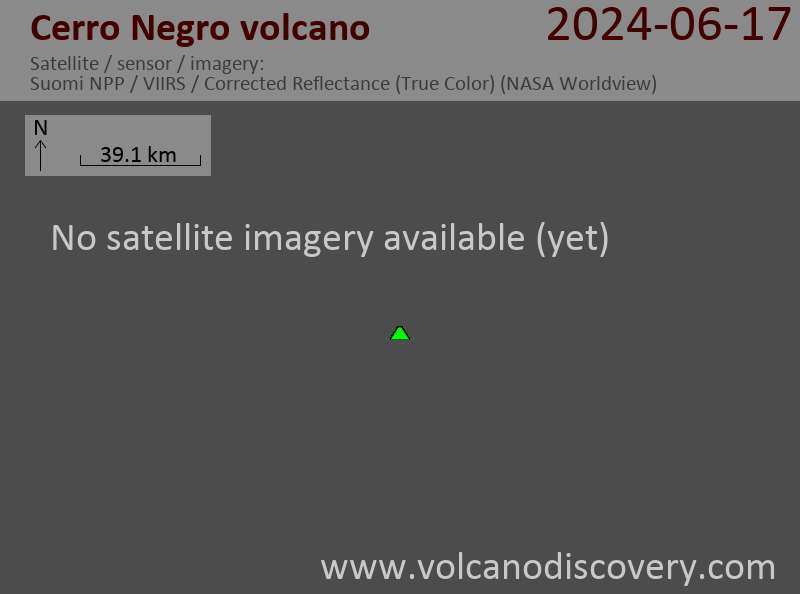Cerro Negro Volcano
Cerro Negro, Central America's youngest volcano was born in April 1850 and is one of the region's most active volcanoes. It has been producing frequent strombolian eruptions, occasional lava fountains and lava flows, and powerful explosive eruptions every few decades.
Cerro Negro lies in a sparsely populated area and its eruptions have not caused significant damage nearby, but ash fall from its sometimes strong explosions have damaged farmland and houses in the populated areas of the Nicaraguan depression.
Cerro Negro volcano eruptions: 1999, 1995, 1992, 1971, 1969, 1968, 1964, 1963, 1962, 1961, 1960, 1957, 1954, 1950, 1949, 1948, 1947, 1929, 1923, 1919, 1914, 1899, 1867, 1850
Latest nearby earthquakes
Background
Cerro Negro is the largest, southernmost, and most recent of a group of 4 young cinder cones that formed along a NNW-SSE-trending line in the central Marrabios Range 5 km NW of Las Pilas volcano. The volcano consists of a black ("negro") basaltic cinder cone with associated lava flows, including an aa flow field reaching 4 km to the NE and SW.The frequent eruptions of Cerro Negro have modified its morphology continuously since its birth 160 years ago.
Significant volcanic eruptions: Cerro Negro volcano
| Date | Note | VEI | Deaths | Damage | |
|---|---|---|---|---|---|
| South flank (near Cristo Rey crater) Historical obs./docs. | 2 | ||||
Historical obs./docs. | 2 | ||||
Historical obs./docs. | 3 | ||||
| 1992 Apr 10 (eruption | Historical obs./docs. | 3 | 11 | moderate | Info |
| Summit and east flank Historical obs./docs. | 3 | ||||
Historical obs./docs. | 1 | ||||
| Summit and south flank Historical obs./docs. | 3 | ||||
?? | Uncertain Eruption | 2? | |||
Historical obs./docs. | 1 | ||||
Historical obs./docs. | 2 | ||||
| NE-flank fissure Historical obs./docs. | 1 | ||||
| Summit and south flank Historical obs./docs. | 3 | ||||
| Summit and east flank Historical obs./docs. | 2 | ||||
Historical obs./docs. | 2? | ||||
Historical obs./docs. | 3 | ||||
Historical obs./docs. | 2 | ||||
Historical obs./docs. | 2 | ||||
| Summit and NE flank Historical obs./docs. | 3 | ||||
Historical obs./docs. | 2 | ||||
| Summit and upper north flank Historical obs./docs. | 3 | ||||
Historical obs./docs. | 2 | ||||
Historical obs./docs. | 2 | ||||
Eruptions of Cerro Negro volcano
An explosive eruption began at Cerro Negro volcano on 5 August. The eruption was preceded by strong seismic activity the previous night, including quakes that were felt in Managua 70 km away.
The explosions produced an ash column reaching 7 km altitude, and consisted of near-continuous pulses, sometimes containing liquid lava fountains up to 300 m tall.
The activity ended already the next day.
An explosive eruption started in the late afternoon of 28 May, following volcanic tremor detected during 24-28 May.
The eruption consisted of small ash explosions about every 30 minutes creating plumes rising a few 100 m and sometimes containing incandescent bombs.
On 30 May, geologists visited the crater and observed that a new vent had formed in the bottom of the central crater.
The eruption continued until 16 August, but its most violent phase was in early June, when explosions occurred on average every 8-15 minutes and sometimes reached up to 1 km height. A small pyroclastic surge was produced by a phreatomagmatic explosion on 2 June.
A violent strombolian eruption occurred at Cerrro Negro volcano between 9-12 April, and a less intense phase from 13-14 April 1992. 28,000 people were evacuated from nearby villages and the outskirts of León, Nicaragua's second largest city.
The eruption produced ash columns reaching 7.5 km altitudeand produced about 4 cm of ash fall in León. Lava fountains of 300 m were observed on the evening of 11 April.
During the second, less intense phase between 13-14 April, ash rose to 3.5 km. All activity stopped on 14 April.
Cerro Negro started a violent eruption from its central vent on 3 February 1971, which consisted in violent strombolian explosions and lava fountains about 500 m tall producing ash columns reaching up to about 10 km, and causing ash fall to the west in up to 80 km distance. Up to 10 cm of ash were deposited in villages near the volcano. The eruption ended on 14 February. ...more info
An explosive and effusive eruption occurred at Cerro Negro volcano around 25 October 1968. A report from 28 Oct reads "tremendous amount of 'smoke'and rock coming out of main cone".
The eruption occurred opened new vents on the south side of the crater, which produced powerful strombolian activity, lava fountains visible from León, and lava flows to the W and SW. Heavy ash fall occurred 10 km from the volcano. 13 villages were evacuated.
The intensity increased on 30 October, when 2 large explosions were observed. A pilot reported the lava flow about 1 km long, 250 wide and 30-40 m thick.
On 4 November, the eruption decreased somewhat. An observer writes: "the new lava vent at the base of Cerro Negro contains a lava fountain shooting molten lava to a height of 30 m into the air. The majority of this material falls back into the pool."
Around 10 November, the eruption intensity picked up again. On 18 Nov, an eruption cloud reached 2-3 km altitude, and lava fountains and continuous ash emissions were observed at the vents. A second lava flow had formed traveling to the SE.
Activity continued in similar ways until 7 December, when it sharply decreased and ended on 10 December.
A series of weak explosions occurred again a year later, in December 1969.
Cerro Negro Volcano FAQ
+When was the last eruption of Cerro Negro volcano?
The last confirmed eruption of Cerro Negro occurred in 1999.
+How often does Cerro Negro volcano erupt?
Since 1850, Cerro Negro volcano has had at least 23 historically documented eruptions. This means that it erupts on average every 7.6 years.
+How active is Cerro Negro volcano at present?
Cerro Negro volcano is relatively active: Since 1900, it has had 20 eruptions, and been active during 20 years out of 126 as of now. This means, Cerro Negro has been in eruption one in 6.3 years on average. The last eruption was in 1999 and ended 26 years ago.
+When was the largest eruption of Cerro Negro volcano?
The largest eruption of Cerro Negro volcano in historic times occurred in 1992. It ranks as a "vulcanian" eruption with a magnitude 3 on the VEI (Volcanic Explosivity Index) scale.
Latest satellite images
Cerro Negro Volcano Maps






































